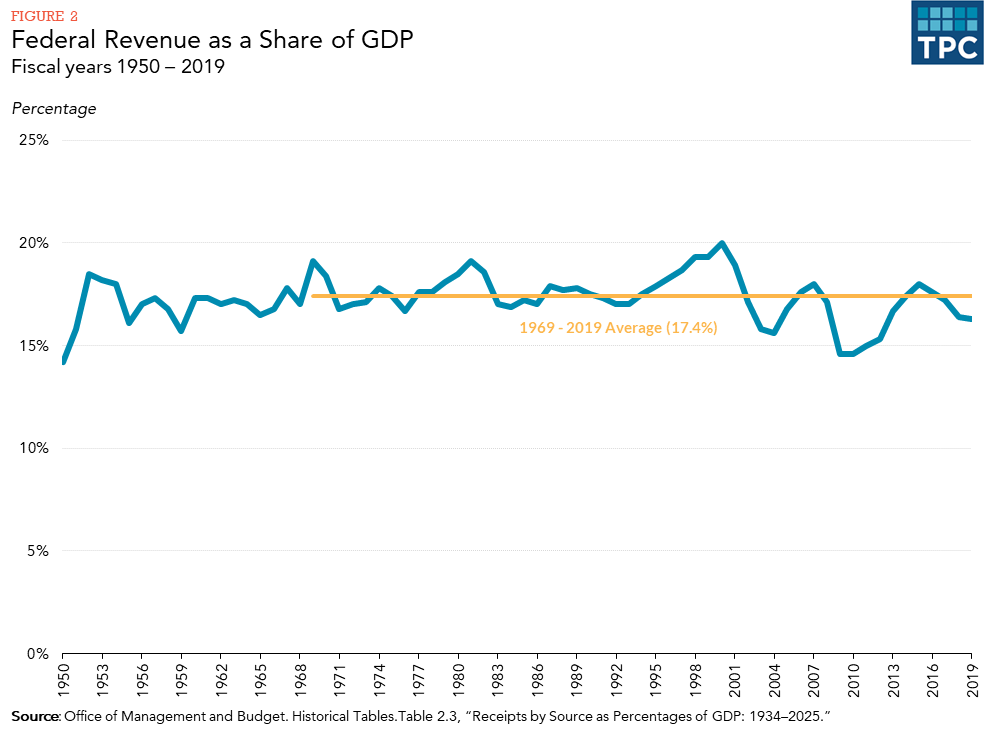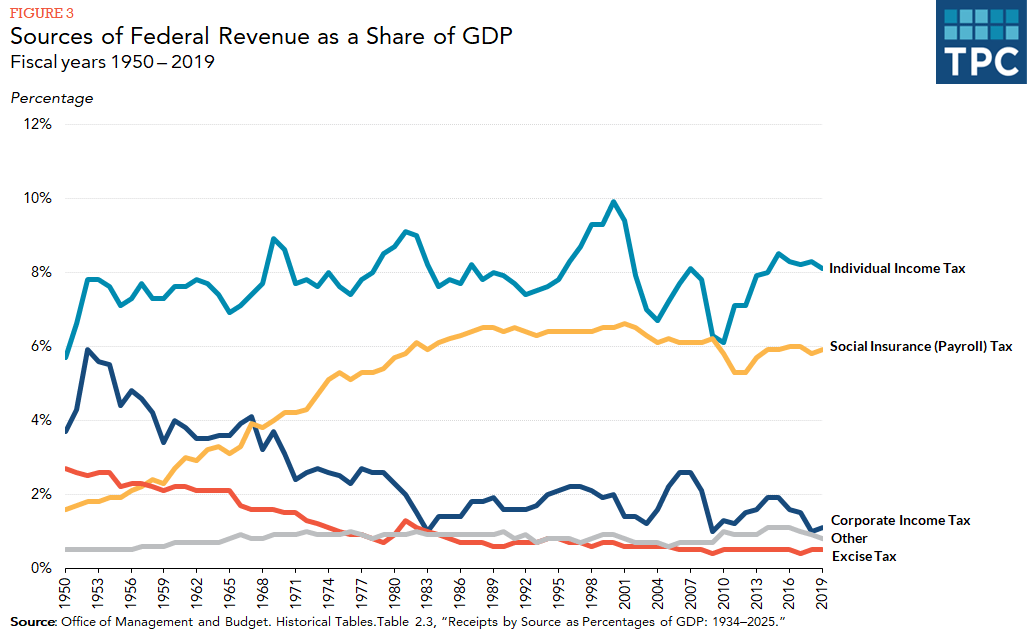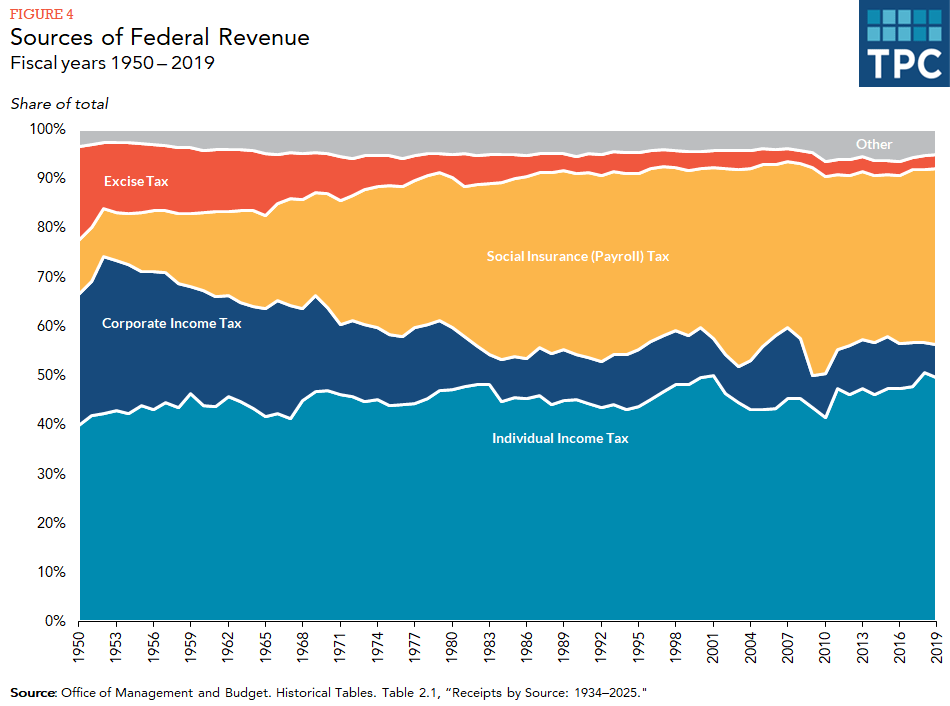THE TAX POLICY CENTER'S
Briefing Book
A citizen’s guide to the fascinating (though often complex) elements of the US tax system.
What are the sources of revenue for the federal government?
FEDERAL BUDGET
1/4>What are the sources of revenue for the federal government?
About 50 percent of federal revenue comes from individual income taxes, 7 percent from corporate income taxes, and another 36 percent from payroll taxes that fund social insurance programs (figure 1). The rest comes from a mix of sources.

TOTAL REVENUES
The federal government collected revenues of $3.5 trillion in 2019—equal to about 16.3 percent of gross domestic product (GDP) (figure 2). Over the past 50 years, federal revenue has aver-aged 17.4 percent of GDP, ranging from 20.0 percent (in 2000) to 14.6 percent (most recently in 2009 and 2010).

INDIVIDUAL INCOME TAX
The individual income tax has been the largest single source of federal revenue since 1950, amounting to about 50 percent of the total and 8.1 percent of GDP in 2019 (figure 3). In recent years, individual income tax revenue has climbed as high as 9.9 percent of GDP (in 2000) at the peak of the 1990s economic boom and dropped as low as 6.1 percent (in 2010) following the 2007–2009 Great Recession.
CORPORATE INCOME TAX
The tax on corporate profits yielded 7 percent of government revenue in 2019, a revenue source that has been trending downward. Revenue from the tax has fallen from an average of 3.7 per-cent of GDP in the late 1960s to an average of just 1.4 percent of GDP over the past five years, and 1.1 percent of GDP most recently in 2019 (figure 3).

SOCIAL INSURANCE (PAYROLL) TAXES
The payroll taxes on wages and earnings that fund Social Security and the hospital insurance portion of Medicare make up the largest portion of social insurance receipts. Other sources in-clude payroll taxes for the railroad retirement system and the unemployment insurance pro-gram, and federal workers’ pension contributions. In total, social insurance levies were 36 per-cent of federal revenue in 2019.
The creation of the Medicare program in 1965, combined with periodic increases in Social Se-curity payroll taxes, caused social insurance receipts to grow from 1.6 percent of GDP in 1950 to 6.2 percent in 2009 (figure 3). A temporary reduction in employees’ share of Social Security taxes—part of the stimulus program following the financial meltdown—reduced social insur-ance receipts to 5.3 percent of GDP in 2011 and 2012. Social Insurance tax receipts have since climbed back to 5.9 percent of GDP in 2019.
FEDERAL EXCISE TAXES
Taxes on purchases of goods and services, including gasoline, cigarettes, alcoholic beverages, and airline travel, generated 2.9 percent of federal revenue in 2019. But these taxes, too, are on the wane: excise tax revenues have fallen steadily from an average of 1.7 percent of GDP in the late 1960s to an average of 0.5 percent over 2015 to 2019 (figure 3).
OTHER REVENUES
The federal government also collects revenue from estate and gift taxes, customs duties, earn-ings from the Federal Reserve System, and various fees and charges. In total, these sources gen-erated 5.0 percent of federal revenue in 2019. They have ranged between 0.6 and 1.0 percent of GDP since 1965 (figure 3). In recent years, the figure has been on the high end of that range be-cause of unusually high profits of the Federal Reserve Board related to its efforts to stimulate the economy since 2008.
SHARES OF TOTAL REVENUE
The individual income tax has provided nearly half of total federal revenue since 1950, while other revenue sources have waxed and waned (figure 4). Excise taxes brought in 19 percent of total revenue in 1950, but only about 3 percent in recent years. The share of revenue coming from the corporate income tax dropped from about one-third of the total in the early 1950s to 7 percent in 2019. In contrast, payroll taxes provided more than one-third of revenue in 2019, more than three times the share in the early 1950s.
Updated May 2020
Office of Management and Budget. Historical Tables. Table 2.1, “Receipts by Source: 1934–2025,” and Table 2.3, “Receipts by Source as Percentages of GDP: 1934–2025.”
Joint Committee on Taxation. 2018. “Overview of the Federal Tax System as in Effect for 2019.” JCX-9-19. Washington, DC: Joint Committee on Taxation.


No comments:
Post a Comment
Note: Only a member of this blog may post a comment.